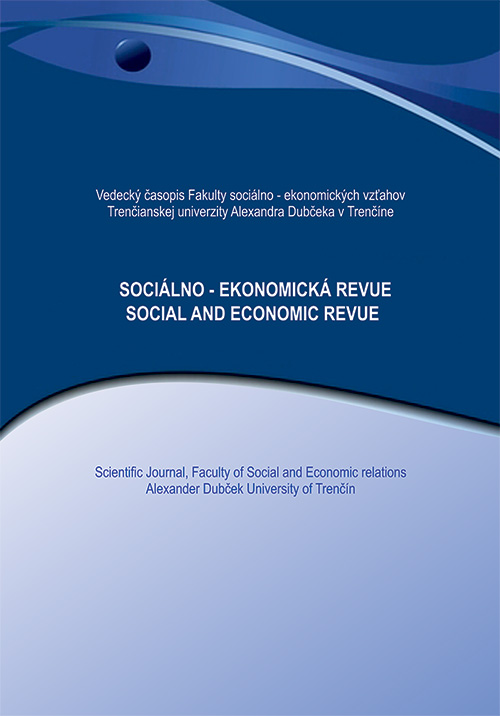ENGAGEMENT, LOYALTY, ORGANIZATIONAL COMMITMENT, JOB SATISFACTION AND MOTIVATION OF PUBLIC ADMINISTRATIONS MANAGERS
When staffing the public administration organizations it is not enough to define the necessary qualifications and knowledge to perform the work. One of the prerequisites for work performance and required work behaviour of employees is their positive attitude to work and organization. The paper deals with working attitudes and motivation as prerequisites for achieving effective work performance for managers in public administration. Job satisfaction is first of all understood as emotional response to which extent the employee perceives his organization and his job as satisfying his needs. Employee satisfaction represents a subjective process of comparing the expectations and the real conditions connected with the aspects of work The aim of the contribution is to identify differences in working attitudes (engagement, loyalty, organizational commitment, job satisfaction) and motivation by elected and appointed representatives of municipal and local authorities and district offices. It has been found that there are no differences in terms of job satisfaction, organizational commitment, loyalty, commitment and motivation among elected and appointed representatives of municipal and local authorities and district authorities.
Release: 2018/1 Pages: 53-66 JEL classification: M12, M54, M53
DOI:
Keywords: public administration, engagement, loyalty, organizational commitment, job satisfaction, motivation
Section: SOCIAL CONTEXT OF THE ECONOMY, LABOR MARKET AND HUMAN RESOURCES DEVELOPMENT
Contacts:
PhDr. Ing. Stanislava Minárová
Faculty of Public adminnistration UPJŠ in Košice
Department of social study
Popradská 66
041 32 Košice
stanislava.minarova@student.upjs.sk
Literature:
Adeyemo, D. A. (2000). Job involvement, career commitment, organizational commitment and job satisfaction of the Nigerian police. A multiple regression analysis. Journal of Advance Studies in Educational Management. Vol. 5(6), pp. 35-41.
Allen, N. J., Grisaffe, D. B. (2001). Employee commitment to the organization and customer reactions: mapping the linkages. Human Resource Management Review. Vol. 11(3), pp. 209-236.
Altindis, S. (2011). Job motivation and organizational commitment amog the health professionals: A questionnaire survey. African Journal of Business Management. Vol. 5(21), pp. 8601-8609.
Andrew, O., Sofian, S. (2012). Individual factors and work outcomes of employee engagement. Procedia-Social and Behavioral Sciences. Vol. 40, pp. 498-508.
Aon Hewit, (2013). Trends in Global Emoloyee Engagement Report Higlights. 2013, s. 4. Dostupné online: http://www.aon.com/attachments/humancapitalconsulting/2013_Trends_in_Global_Employee_Engagement_Report.pdf
Armstrong, M. (2009). Armstrong's Handbook of Human Resource Management Practice. London: Kogan Page Limited, 2009.
Armstrong, M. (2007). Odměňování pracovníků. 2.vyd. Praha: Grada. 448 s. ISBN 978-80-247-2890-2.
Baldwin, J. N., Farley, Q. A. (1991). Comparing the public and private sectors in the United States: A review of the empirical literature. In A. Farazmand (Ed.), Handbook of comparative and development public administration. New York: Marcel Dekker. pp. 27-39.
Bašistová, A., Ferencová, M. (2014). Analýza spokojnosti zamestnancov v kontexte zmien pracovných podmienok a faktorov. Psychológia práce a organizácie 2014. Spoločensko-vedný ústav SAV, Košice 2014. s. 27 – 37.
Berryová, L. M. (2009). Psychológia v práci. 2. vyd. Bratislava: Ikar, 2009. 693 s. ISBN 978-80-551-1842-0.
Bláha, J. et. al. (2013). Pokročilé řízení lidských zdrojů. Brno: Edika, 2013. s. 264. ISBN 978-80-266-0374-0.
Bláha, J. et. al. (2016). Řízení lidských zdroju. Nové trendy. Praha: Management Press, 2016. s. 428. ISBN 978-80-7261-430-1.
Bothma, F. C., Roodt, G. (2012). Work-based identity and work engagement as potential antecedents of task performance and turnover intention: Unravelling a complex relationship. SA Journal of Industrial Psychology. Vol. 38(1), Art. #893, 17 pages. doi.org/10.4102/sajip.v38i1.893
Desantis, V. S., Durst S. L., (1996). Comparing job satisfaction among public and private sector employees. American Review of Public Administration. Vol. 26(3), pp. 327-343.
Emmert, M. A., Taher, W. A. (1992). Public sector professionals: The effects of public sector jobs on motivation, job satisfaction and work involvement. American Review of Public Administration. Vol. 22(1), pp. 37-48.
Field, L. K., Buitendach, J. H. (2011). Happiness, work engagement and organisational commitment of support staff at a tertiary education institution in South Africa. South African Journal of Industrial Psychology. Vol. 37(1), pp. 1-10.
Gabris, G. T., Simo, G. (1995). Public sector motivation as an independent variable affecting career decisions. Public Personnel Management. Vol. 24(1), pp. 33-51.
Greenberg, J., Baron A. R. (2003). Behaviour in Organisations”, Prentice Hall, Vol. 8, pp. 188-215.
Hackman, J. R., Oldham, G. R. (1976). Motivation through the design of work: Test of a theory. Organizational Behavior and Human Performance. Vol. 16, pp. 250-279.
Halbesleben, J. R., Harwey, J., Bolino, M. C. (2009). Too engaged? A conservation of resources view of the relationship between work engagment and work intefferece with family. Journal of Applied Psychology, 2009. Nov. 94(6), pp. 1452-1465. doi: 10.1037/a0017595.
Halík, J. (2008). Vedení a řízení lidských zdrojú. Praha: Grada, 2008. 128s. ISBN 978-80- 247-2475-1.
Harausová, H. (2015). Motivácia - pracovná spokojnosť - výkonnosť a výkon zamestnancov organizácií verejnej správy. Košice: Univerzita P. J. Šafárika v Košiciach. 105 s. ISBN 978-80-8152-362-5.
Hart, D. W., Thompson, J. A. (2007). Untangling employee loyalty: A psychological contract perspective. Business Ethics Quarterly. Vol. 17, pp. 297-323.
Harter, J. K. et. al. (2002). Business-unit-level relationship between employee satisfaction, employee engagement, and business outcomes: A meta-analysis. Journal of Applied Psychology. Vol. 87, pp. 268-279.
Hay Group. (2011). Engage Employees and Bcast Performance, 2011, s. 7 online. 15.12.2015. Dostupné z: http://www.haygroup.com/us/downloads/details.aspx?id=7343.
Chow, S., Holden, R. (1997). Toward an Understanding of Loyalty: The Moderating Role of Trust. Journal of Managerial Issues. Vol. 9, no. 3, pp 275-298.
Jackson, S. E., Schuler, R. S., Werner, S. (2009). Managing human resources (10 ed.). Mason: Cengage.
Jenkins S., Delbridge R. (2013). Context Matters: Examining Soft and Hard Approaches to Employee Engagement in Two Workplaces. International Journal of Human Resource Management. Vol. 24(14), pp. 2670-2691.
Jung, J., Shin, J. Ch. (2014). Administrative staff members’ job competency and their job satisfaction in a Korean research university. Studies in Higher Education. 2014.
Jung, K., Moon, M. J., Hahm, J. S. (2007). Do age, gender, and sector affect job satisfaction? Results from the Korean labor and income panel data. In: Review of Public Personnel Administration. Vol. 27, no. 2, p. 125-146.
Kahn, W. A. (1990). Psychological conditions of personal engagement and disengagement at work. Academy of Management Journal. Vol. 33(4), pp. 692–724.
Kemp, P. E. (1967). Commitment and Job Satisfaction. Journal of coopeerative extension, vol. X, pp. 171–177.
Kollárik, T. (1983). Človek v sociálnom systéme práce. 1. vyd. Bratislava: Práca. 214. s. 1983.
Kollárik, T. (2002). Sociálna psychologia práce. Bratislava : UK. s. 190. 2002. ISBN 80-85943-57-3.
Koprulu, O. M. (2013). Examining the antecedents of organizational commitment in the context of un and eu police contingents in conflict and terror areas. Dostupné online:http://dga.rutgers.edu/wp-content/uploads/2012//10/Examining-theAntecedentsofOrganizational-Commitment-in-the-Context-of-UN-and-EU-Police-Contingents-inConflict-and-Terror-Areas.pdf
Kravčáková G. a kol. (2013). Organizačné správanie. 1. vyd. Košice: UPJŠ v Košiciach. 192 s. ISBN 978-80-8152-214-7.
Macey, et al. (2009). Employee engagement: Tools for analysis, practice and competitive advantage. Wiley-Blackwell Ltd. UK. 2009.
Mathieu, J., Zajac, D. (1990). A review of meta-analysis of the antecedents, correlates and consequences of organizational commitment'', Psychological Bulletin, Vol. 108 No. 2, pp. 171-94.
Mendes, F., Stander, M. W. (2011). Positive organisation: The role of leader behaviour in work engagement and retention. South African Journal of Industrial Psychology. Vol. 37(1), pp, 1-13. doi: http://dx.doi.org/10.4102/sajip.v38i1.900.
Mercer´s Employe Engagement Model. (2017): Dostupné online: https://www.slideshare.net/PingElizabeth/mercer-whats-working-research.
Mesárošová, M. (2004). Motivácia verejnej služby a komunikácia študentov verejnej správy. Podniková ekonomika a manažment. Brno: Masarykova univerzita v Brne, s. 240-247.
Meyer, J. P. (1997). Organizational commitment. International Review of Industrial and Organizational Psychology. Vol. 12, pp. 175 – 228.
Meyer, J. P. (2013). The science-practice gap and employee engagment: Its a matter of principle. Canadian Psychology. Vol. 54, pp. 235–245.
Meyer, J. P., Allen, N. J. (1991). A three-component conceptualization of organizational commitment. Human Resource Management Review. Vol. 1, pp. 61-89.
Meyer, J. P., Allen, N. J., Smith, C. A. (1993). Commitment to organization and occupations: Extensions and tests of a three-component conceptualization. Journal of Applied Psychology. Vol. 78, pp. 538 – 551.
Mitchell, T. R., Lason, J. R. (1987). People in Organization. 3rd ed., New York: McGraw-Hill
Mowday, R. T., Steers, R. M., Porter, L. M. (1979). The measurement of organizational commitment. Journal of Vocational Behaviour. Vol.14, pp. 224–227.
Newman, D. A, Joseph, D. L., Hulin Ch. L. (2010). Job attitudes and employee engagement: Consedering the attitude A-factor. The handbook of employee engagement: Perspectives, issues, research and practice. p. 43 – 61.
Newstrom, J.W., Davis, K. (1993). Organizational behavior. Human behavior At work. 9th Edition, New York:McGraw-Hill.
OReilly, C. A., Chatman, J. A. (1986). Organizational commitment and psychological attachment: The effects of compliance, identification and internalization on prosocial behavior. Journal of Applied psychology. Vol. 71, pp. 492-499.
Papcunová, V., Gecíková, I. (2011). Metódy a techniky regionálnej analýzy. Bratislava: VŠEMvs,. 2011, 148 s. ISBN 978-80-89393-39-8.
Perry, J. L., Wise, L. R. (1990). The Motivational Bases of Public Service. Public Administration Review. Vol. 50(3) pp. 367–373.
Porter, L. W. et. al. (1974). Organizational commitment, job satisfaction, and turnover among psychiatric techni- cians. Journal of Applled Psychology. Vol. 59, no 603-609.
Prucha, P. (2004). Správní právo. Obecná část. 6. doplněné a aktualizované vydání. Masarykova univerzita a nakladatelství Doplněk. Brno 2004, ISBN 80-210-1814-3.
Rainey, H. G. (1997). Understanding and managing public organizations. 2nd ed San Francisco: Jossey-Bass. 1997.
Reichheld, F. F. (2001). Loyalty Rules! How Today s Leaders Build Lasting Relationships. Boston, MA: Havard University Press.
Richman, A. (2006). Everyone wants an engaged workforce how can you create it? Workspan. Vol. 49, pp. 36-39.
Robbins, S. P. (2005). Organizational Behavior, Upper Saddle River, New Jersey, Pearson, Prentice Hall
Ryan, R. M., Deci, E. L. (2000). Intrinsic and Extrinsic Motivations: Classic Definitions and New Directions. Contemporary Educational Psychology. Vol. 25(1), pp. 54–67.
Salanova, M., Agut, S., Peiro, J. M. (2005). Linking organisational resources and work engagement to employee performance and customer loyalty: The mediation of service climate. Journal of Applied Psychology. Vol. 90(6), pp. 1217–1227. doi: http://dx.doi. org/10.1037/0021-9010.90.6.1217.
Shaw, K. (2005). An engagement strategy process for communicators. Strategic Communication Management. Vol. 9(3), no 26-29.
Shepherd, J. L., Mathews, B. P. (2000). Employee commitment: academic vs practitioner perspectives. Employee Relations. Vol. 22 Iss: 6, pp. 555 – 575.
Shermerhorn, J. R., Hunt, J. G., Osborn, R. N. (1994). Managing Organizational Behavior. John Wiley a Sonc, Inc., New York, 1994.
Schaufeli, W. B., Bakker, A. B. (2004). Job demands, job resources and their relationship with burnout and engagement: A multi-sample study. Journal of Organizational Behavior. Vol. 25, pp. 293-315.
Schaufeli, W. B., et. al. (2001). Maakt arbeid gezond? Op zoek naar de bevlogen werknemer [Can work produce health? The quest for the engaged worker]. De Psycholoog. Vol. 36, pp. 422–428.
Spector, P. E. (1985). Measurement of Human Servise Staff Satisfaction: Development of the Job Satisfaction Survey. American Journal o Community Psychology. Vol. 13, no. 6.
Su, X., Bozeman, B. (2009). Do Expectations Meet Aspirations? The Relation of Public Managers Job Choice Motives to Job Satisfaction. International Review of Public Administration. Vol. 14, no. 1, pp. 1-9.
Taylor, J., Westover, J. H. (2011). Job Satisfaction in the public service: The effects of public service motivation, workplace attributes and work relations. Public Management Review. Vol. 13, No. 5, pp. 731-753.
Turkyilmaz, A. et. al. (2011). Empirical study of public sector employee loyalty and satisfaction. Industrial Management & Data Systems. Vol. 111(5), pp. 675-696.
Van Dick, R. (2004). Commitment und Identifikation mit Organisationen. Gottingen: Hogrefe.
Vandenabeele, W. (2007). Toward a Public Administration Theory of Public Service Motivation: An Institutional Approach. Public Management Review. Vol. 9(4), pp. 545–556.
Varona, F. (2002). Conceptualization and Management of Communication Satisfaction and Organizational Commitment in Three Guatemalan Organizations. American Communication Journal. Vol. 5(3), pp. 114-136.
Wu, L., Norman, I. J. (2006). In investigation of job satisfaction, organizational commitment and role conflict and ambiguity in a sample of Chinese undergraduate nursing student. Nurse Education Today. Vol. 26, pp. 304-314.
Župová, E. (2014). Vzťah kompetentnosti, pracovného výkonu a výkonnosti organizácie v organizácii verejnej správy. Aplikácie informačných technlógií = Information Technology Applications. Vol. 3, no. 2, pp. 33-38.


